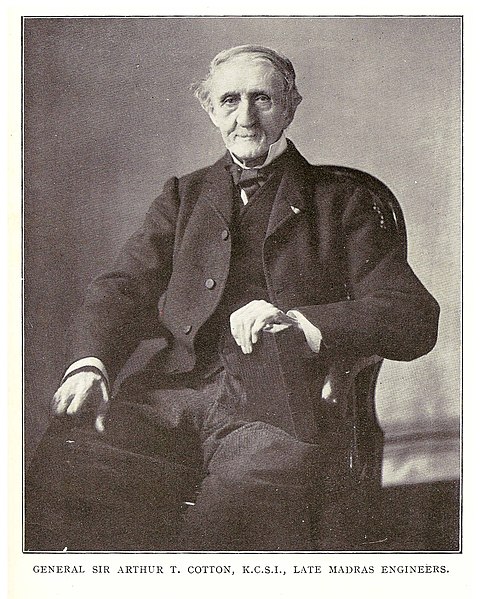Most Indians believe that the first train in India ran in 1853 between Bori Bunder in present day Mumbai and Thane, but that was the first passenger train. The very first train in Indian history arrived almost two decades before that. Here’s the astonishing story about The Red Hills Railway. Steam engines were definitely involved, but so were cattle and even wind! How was that possible?
It all started with Captain Cotton, a brilliant, military engineer focused on providing cheap and efficient transport. Turns out, that’s just what the Madras Presidency needed in the 1830s. The British government was concerned about the large and unproductive expenditure upon public roads in this presidency and the need for more economical and efficient ways to manage transport. Captain Arthur Cotton suggested a rail track from the Red Hillsto the stone quarries at Little Mount to help carry material required for road building. This would save nearly half or roughly 28,000 rupees of the government’s annual expenditure on roads. To demonstrate feasibility, an experimental track was set up near the Chintadripet Bridge. In September of 1836, Captain Cotton waved the green lantern and work began on the Red Hills Railway.
A three-mile-long railway track was laid from the entrance of the Red Hills quarry to a canal across the Retteri Tank (Lake). From there, via two canals, the cargo would reach Madras. The route would avoid the construction of expensive bridges. Landing stages were built at Georgetown, St Mary’s and Government Gardens. The first Iron and Steel Factory in India supplied the tracks for the railway from Porto Novo, which was 220 km away. The line was opened in 1837 and over 1,250 tons were transported within the first three months. Captain Cotton notes in his report that one bull could pull 9 common bandy loads roughly 400 kg of stone on the track, which would have taken 18 bulls to pull on the common roads. It would appear that the first engines were actually bulls!
There were at least two locomotives that were tested out on this track. The first one was too weak, it’s boiler could not produce enough steam to pull the load. Modifications were made and a new engine was constructed in September 1838 with a better boiler and it achieved a speed of 4.5 miles per hour hauling 3.5 tons. Further developments were stopped by the government and Captain Cotton’s proposal to utilise the line for passenger traffic was also turned down.
But a newspaper report in January 1838 spoke of a most unusual journey. A passenger carriage was sailing on the rail track drawn by the wind. It was fitted with a lugsail, travelled at 12 miles per hour and could carry up to five persons. Astonishingly when the wind was too strong, the sail had to be eased to reduce speed and prevent the carriage from going off track.

Unfortunately, before Captain Cotton could continue his experiments, his innovation journey was cut short by illness and he had to leave Chennai. Being the primary force behind the Red Hills Railway project, it soon came to a premature end. Several other proposals were made to set up railways, including the formation of the East Indian and Great Indian Peninsular Railways but they remained on paper. It took another decade and Lord Dalhousie’s famous two-hundred-page Railway Minute to finally get the possibility of trains, back on track again.
Captain Cotton on the other hand went on to build many wonderful irrigation and navigation canals throughout British India. In 1861, he was knighted. The legacy of Captain Cotton’s pioneering initiative much like an old steam engine is in much need of restoration.
To hear other tales from the annals of history, join us on one of our walking tours.
You can also download the Storytrails App and discover a city all by yourself through our location aware Audio Tours.
Archives
- January 2022
- December 2021
- November 2021
- August 2021
- March 2021
- February 2021
- January 2021
- December 2020
- November 2020
- October 2020
- September 2020
- August 2020
- April 2020
- March 2020
- February 2020
- January 2020
- November 2019
- October 2019
- September 2019
- August 2019
- July 2019
- June 2019
- August 2017
- February 2017
- January 2017
- October 2013
Featured Posts
- Tales that pots tell: Keeladi excavations AUGUST 18, 2021
- The Last Grand Nawab: Wallajah FEBRUARY 10, 2021
- How Tej Singh became Raja Desingu of Gingee FEBRUARY 5, 2021
- How Shahjahan seized the Mughal throne JANUARY 28, 2021
- Alai Darwaza – Qutub Minar Complex, Delhi NOVEMBER 21, 2020
- Marking History through British buildings NOVEMBER 17, 2020
- The last great queen of Travancore NOVEMBER 7, 2020
- Brahmi and the evolution of scripts OCTOBER 15, 2020
- The Cambodian King of Kanchipuram OCTOBER 14, 2020
- James Prinsep – the man who read the writing on the wall OCTOBER 10, 2020
- Mariamman – the Village Goddess who travelled SEPTEMBER 30, 2020
- Misnamed Monuments of Mamallapuram SEPTEMBER 28, 2020








